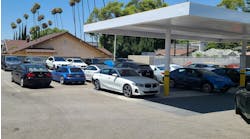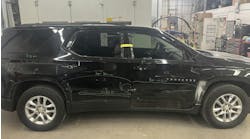With the right painting techniques and practices you can cut VOCs while pumping up your profits
Let's look at some of the statistics about VOC discharge. According to one paint manufacturer, about 15.6 percent of the VOCs that are emitted into the atmosphere come from new automotive finishes and 6.6 percent from automotive refinishes. The federal Environmental Protection Agency (EPA) estimates that in the automotive refinish industry, surface preparation contributes 8 percent, undercoat application contributes 17 percent and topcoat application (that is, both solvent-borne basecoat and clearcoat) contribute 55 percent, with equipment cleaning contributing the remaining 20 percent.
For years, state and federal governments have passed environmental laws regulating the amount of VOCs that can be used in finishes to help reduce VOCs in the atmosphere. New equipment, like the high volume low pressure (HVLP) spray gun, has been developed and its use has been mandated to help reduce the amount of carbon load emitted. In certain parts of North America, the use of waterborne basecoat has been mandated to further reduce VOC emissions.Though most of the VOCs have been removed from waterborne finishes, there is still a small amount remaining that will by its design evaporate into the atmosphere as well. Clearcoats are still solvent-borne products laden with VOCs that will be emitted into the atmosphere.
Governments and paint and equipment manufacturers have taken steps to reduce VOC levels. Is there anything more a collision repair company and its painters can do? Absolutely.
The answer lies in the painter's transfer efficiency (TE). There are many paint guns, both HVLP and non-HVLP (sometimes called "compliant" paint guns), that can spray at 65 percent or higher transfer efficiency. When put into the hands of some painters, though, these highly efficient guns do not always spray to their most efficient potentials. To have a paint gun operate to its fullest potential, a painter must control an array of factors such as air flow of both volume and pressure, gun adjustment, tip size, distance, application technique, coating reduction and equipment cleaning.Air flow
Without question, HVLP spray guns are capable of very high levels of transfer efficiency. According to a chart produced by the University of Northern Iowa, HVLP spray equipment transfer efficiency can be as high as 80 to 90 percent (turbo), and according to manufacturer claims, some non-HVLP guns can have a transfer efficiency rate as high as 65 percent.
It also is true that HVLP spray guns, with their lower pressures, are more difficult to operate. Often painters opt for a compliant gun because they believe they produce a better finish. With a little training and perseverance, painters can produce excellent finishes with HVLP guns when used correctly.
Volume: One of the most important considerations is the air needed to operate an HVLP gun. These guns need, as their name implies, a high volume of air to atomize coatings properly. To provide the necessary volume, the air supply hose should possess a 31/48th-inch inside diameter (ID) with high-volume, quick-change fittings.
If an HVLP spray gun were to be fitted with a smaller air inlet, the gun would continually be starved for volume and would not operate correctly. The type of air regulator can starve an HVLP gun as well. The least expensive air regulator has a "gate valve" type regulator. When the valve is turned, it decreases the air pressure but does so by restricting the volume of air as well, thereby starving the gun.
Spray guns typically have two types of regulators: a gate valve regulator and diaphragm type. The diaphragm type reduces the air pressure to the correct amount but does not restrict its volume and as such does not starve the gun.Another type of valve that painters must be careful when using is the air pressure valve with which some spray guns are equipped. Many of these valves are air-volume-restrictive as well. When used, they restrict the air pressure by reducing the volume of air through the gun, again starving the gun.
Pressure: There was a time that we would set all guns at 60 to 70 lbs. per square inch (PSI) and they would operate properly. Today each gun has its own specific air pressure at which it operates optimally, which means not only operating properly to produce a good-looking finish but also at the best transfer efficiency rate. Some gun companies have all their guns operate at the same pressure, such as 29 PSI, while others specify 17 PSI for some guns and 20 PSI for other guns in their operating line. Smart observers will note that if a gun company specifies a single pressure (like 29, for ex-ample, rather than a range such as 25-30 PSI), using this pressure is critical for TE.
By definition, an HVLP spray gun should operate at no higher pressure than 10 PSI at the tip. Though gauges to measure gun tip pressures are available, most body shops do not use them and rely instead on the gun manufacturer's recommendations. To have a gun operate at the highest transfer efficiency, the precise operating air pressure should be observed.Gun adjustment
Gun adjustment is critical. The old practice of operating a gun at "full open" no longer assures the gun is operating as designed. With HVLP guns and the higher viscosity and solid content of today's coatings, lower pressures will not properly atomize paint. The old method of adjusting a gun was to set the fan at maximum and the fluid open all the way and to increase pressure to break up the large amounts of fluid that would come through the gun. Today, a gun's fluid adjustment should be set so the smallest or most atomized paint particles are achieved. The smaller the particles coming from the gun, the smoother the finish will flow out on the surface of the vehicle. This is true for undercoats such as sealers or blending clears. If these products do not lie flat on the vehicle, everything to follow is not going to be smooth either.
Remember, the larger the quantity of fluid that comes through the gun, the greater the level of air volume or the pressure will be needed to atomize it. That is why painters who wish to reduce their VOC output need to choose the precise tip size for the coating that is being used.
Tip size
Tip size regulates the amount of paint that can come through the gun. The larger the tip size (1.8 or 2, for example), the larger the amount of paint that will come through the gun.
We commonly see recommendations ranging from 1.2 to 1.4, and painters often ask which recommendations they should follow — the one from the paint gun manufacturer or from the paint manufacturer. Paint gun companies sell guns suitable for all types and brands of coatings. That is why the recommendations are given in a range such as 1.2 to 1.4. Paint companies also sell coatings that can be shot through all types of guns. To get the most accurate recommendation, a painter should find the recommended paint gun tip size for the coating he or she is using. Most paint companies on their Web sites will list the exact paint gun tip size for a specific paint coating. For the best results and best transfer efficiency, the given size should be followed.
Distance
The distance a gun is held away from the surface of the object being painted is highly critical for both appearance and transfer efficiency. Paint guns are external-mix tools. That means that the majority of air used to atomize the paint is introduced into the paint stream after the paint leaves the gun. As the air from the cap horns hits the paint that is being pushed out of the gun, large droplets break into smaller ones. The paint is generally at its smallest when it reaches about 5.5 to 6.5 inches away from the gun. After that point, the droplets become less atomized, or larger. Therefore, if a gun is held either too close to or too far from the object being painted, it will have texture or poor flow-out. It also will have poor transfer efficiency if the distance isn't optimal.
Paint gun laser aiming devices are available for painters to help them maintain the critical distance while painting. If the laser is held too far from the set distance, it will display two red dots. If held too close, it also will display two dots. When the proper distance is maintained, only one dot should be visible. For painters to learn how to maintain proper distance, these tools can be very helpful, particularly during any kind of initial training.
Application
Application technique also is one of the most critical factors for high transfer efficiency. During application, the skill of a painter becomes most valuable when parameters such as targeting, lead and lag, rotation and banding must be taken into account.
Each of these factors can affect the appearance of the finish and significantly impact the transfer efficiency of the painter. With improper application, even HVLP guns operating at their greatest efficiency may not produce the 62 to 65 percent transfer efficiency needed to reduce VOC emissions.
Targeting: Painters have for years been taught to paint at a 50-percent overlap, with the first coat pointed half on and half off the target. If this is followed, half of the sprayed coating will miss the target and thus use only 50 percent of the gun's TE. In addition, if a 50-percent overlap is maintained, today's colors (metallic, pearl, and multi-stage colors) are more likely to streak or mottle. A better practice is 75-percent overlap. With less fluid coming out of the gun, this method will produce a finish with better coverage and fewer defects, such as streaking.
Lead and lag: Painters also used to be instructed to start the paint stroke before they reached the target and continue to do so after they had left the target. And though lead and lag are still necessary, they should be kept to a minimum. Painters who become skilled at banding can keep lead and lag very small. One of the reasons that lead and lag are necessary is that most painters off-trigger completely between each stroke. If they do this, the gun may spit paint when it is triggered again. Because of off-triggering, painters often subconsciously extend their lead and lag, so that any spitting will not be on the vehicle.
A better method involves not completely off-triggering between strokes. Instead, the painter off-triggers the fluid flow but maintains the air coming out of the gun. This will eliminate spitting in a properly operating gun.
Rotation: Rotation, or fanning, means a painter turns the fan from a parallel target. When this happens, the proper overlap and distance is not maintained. As a result, the finish may not cover properly and be streaky or mottled. A painter must be sure to maintain a perpendicular pattern to the vehicle to obtain the desired appearance and TE. Though rotation is often a practice painters should avoid when banding, rotation can help increase TE.
Banding: Banding is a technique in which the painter sprays the first strokes around the perimeter of the part. This allows the painter to keep the lead and lag so small that it is nearly non-existent, and therefore much more paint hits the target. A painter's TE increases significantly when using this method.
When banding, a painter should rotate the gun so that all the spray hits the edge of the part being painted. When a gun is rotated, a greater quantity of paint deposits on a smaller area, which means the paint may be applied too heavily. Normally, a spray gun should be fully triggered to maintain a consistent coating thickness. When banding, it is advisable to partially trigger a gun. This takes some practice and observation on the part of a painter, but when mastered it can increase a painter's quality and efficiency.
Coat-and-a-half of clear: Most paint companies recommend that at least two mils of clear finish coat be applied over newly applied basecoat to obtain proper protection. But most painters will blend an area to coverage with basecoat and then apply two full coats to the remainder of the panel. This often means that a large quantity of clear is applied over OEM clear, which may not be necessary. Applying the first coat of clear to just beyond the blended area, with a second coat of clear applied over the entire panel, will satisfy the 2-mil requirement for clear protection and not apply more than is necessary to the existing OEM clear finish. By applying only 1.5 coats of clear, the reduction of clear will reduce the VOC emissions. Shops should check with their paint company's recommendations to see if this method will fit into the company's guarantee parameters.
Reduction
Because of the differing federal, state and local laws regarding reduction of paint, altering the recommended amounts of reducer added to paint is not recommended. But the proper choice of reducer and hardeners can have a significant impact on appearance. All solvents placed into a paint eventually will evaporate, emitting VOCs. Therefore, over-reduction of paint, a practice used by some painters to achieve proper appearance with high solids paints and HVLP guns, should be avoided. If a coating is over-reduced, the TE goes down very rapidly and more VOCs are released into the environment.
Cleaning
Cleaning equipment can produce up to 20 percent of the VOCs released in a collision shop. Though many practices will reduce cleaning VOCs, cleaning first in an enclosed gun cleaner that prevents the escape of VOCs, is the most valuable practice to start with. Using disposable paint cups also reduces the amount of cleaner needed, and recycling cleaning solvent can reduce the amount of solvent used for cleaning. Cleaning solvent, when recycled, can be used multiple times. Some shops report that they have reduced their solvent usage by 200 to 300 percent through recycling. When less solvent is used, less solvent is vented as VOCs.
Final word: A win-win situation
When considering VOC reduction, the typical initial comment that arises is: "Wow, this seems complicated and hard. Why should I do it?" The reaction is only natural since in some people's minds the warnings of increased carbon load and global climate change may not be true. The next thought often is: "If it's not as bad as they say, this is a lot of work for something that may not be necessary."
Granted, if the only benefit was reduction of the carbon footprint, one could argue that reducing VOCs is more bother than it's worth. But significant benefits remain, even when carbon load is not the only question. Reduction of VOCs actually is a double green endeavor. Along with cleaning up the environment, reducing VOCs also reduces the quantity of paint a shop uses. Cutting this expense raises revenues. Wet materials are among the most costly products purchased by a shop. If painters increase their TE, they reduce materials. With profit margins being as tight as they are, increasing profits by increasing transfer efficiency is a good idea.




